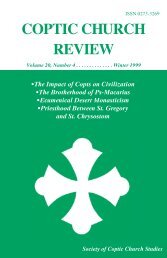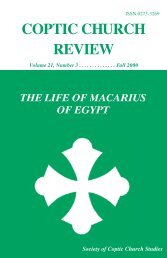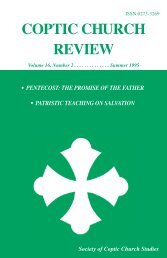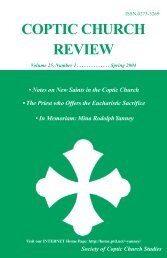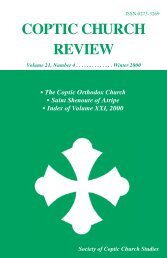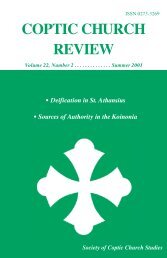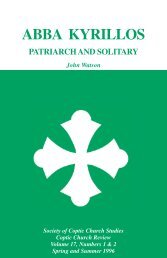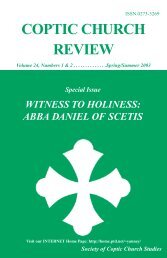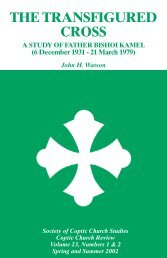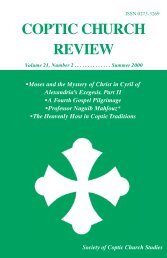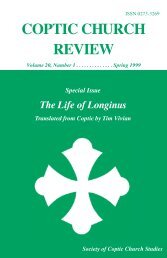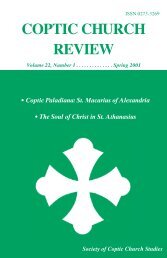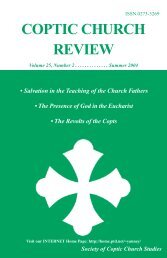2004 Fall.Vol25.#3.pdf - Coptic Church Review
2004 Fall.Vol25.#3.pdf - Coptic Church Review
2004 Fall.Vol25.#3.pdf - Coptic Church Review
Create successful ePaper yourself
Turn your PDF publications into a flip-book with our unique Google optimized e-Paper software.
72 <strong>Fall</strong> <strong>2004</strong> • <strong>Coptic</strong> <strong>Church</strong> <strong>Review</strong> - Volume 25, Number 3<br />
expresses the bare and emptying experience of entering one’s own loneliness as the<br />
only access to the contemplation of unexpected reality. 27 The lessons of the modern<br />
and the traditional are not distinct. From the iconographic tradition to the distinctly<br />
modern we may know most deeply, in ways that are beyond ordinary scrutiny and<br />
beyond any restrictive system of belief, where our personal truth may be found.<br />
The questions raised in this necessarily brief paper cannot die. Fortunately,<br />
these issues do find expression in many countries where Christian iconography and<br />
religious art maintain some hold upon the popular imagination and religious consciousness.<br />
Britain’s leading journal exploring the boundaries between the churches<br />
and the visual arts is Art and Christian Enquiry Bulletin. 28 The ACE Trust was<br />
formed to respond to the evident need for a forum in which those concerned with<br />
the encounter between arts and Christianity could share their interests. But it<br />
should be immediately clear that although debate in this area occupies a central<br />
place any consensus is rare. 29 In the wider conversation concerning the enrichment<br />
of theology through the arts, debate and acrimony sometimes overtake discussion.<br />
Instrumentalism is generally described as the use of art to communicate preformed<br />
messages, and of the use of visual arts in particular to preach. Is modern<br />
Art, in all its variety, the handmaid of religion? If it is then Art’s integrity is<br />
crushed. Aestheticism is that other extreme in which art is rescued from theology<br />
and operates in an altogether value-free environment. It is a world of art in which<br />
the most vague concepts and designs float before our eyes and in our minds. 30 In<br />
an area that is said to be free of instrumentalism and aestheticism, the claim is frequently<br />
made that modern explorations into Art will lead us into a place where theologians<br />
and artists can together explore the Gospel and the <strong>Church</strong>. What ‘language’<br />
is being spoken in this dialogue is far from clear. 31 This is why a theologian<br />
and an artist can both find it so difficult to engage in a tête-à-tête. They are speaking<br />
different languages, unless they agree to a common ground based upon certain<br />
accepted assumptions that immediately define and delimit the freedoms and<br />
responsibilities of both artist and theologian. The overwhelming impression from<br />
the rather tense exchanges in Art and Christianity Enquiry Bulletin is that the<br />
processes described by Richard Wollheim are those closest to Orthodoxy and to<br />
those of us who focus upon the icons of Isaac Fanous, Stephan René and Adel<br />
Nassief. We may learn more about ourselves than we do from an arcane approach<br />
to iconography that closes our eyes through our minds.<br />
27 See esp. Beyond Belief: Modern Art and the Religious Imagination, Rosemary Crumlin. National<br />
Gallery of Victoria, Australia. 1998.<br />
28 In July <strong>2004</strong> (Edition No 39. ISSN 1464 4363) Art and Christianity Enquiry Bulletin was renamed<br />
Art and Christianity.<br />
29 The main protagonists in the debate are David Jasper, Professor of Literature and Theology and the<br />
University of Glasgow and Jeremy Begbie, Director of Theology Through the Arts at the University<br />
of St Andrews, Scotland.<br />
30 See. Scandalous Art, Scandalous Theology, Jeremy Begbie. ACEB, April 2003.<br />
31 See. A Response to Jeremy Begbie, David Jasper. ACEB, July 2003.




